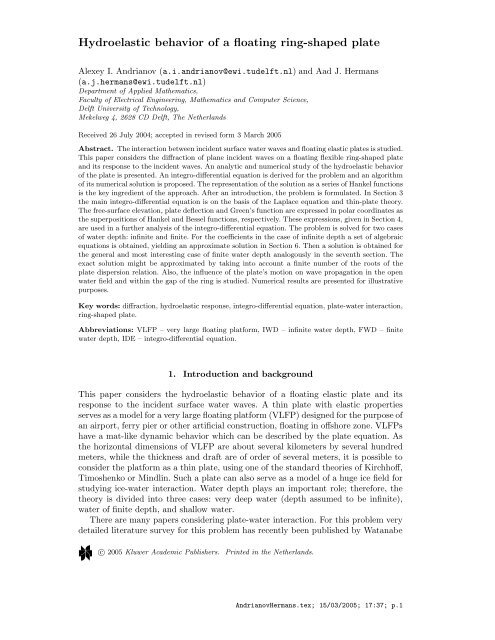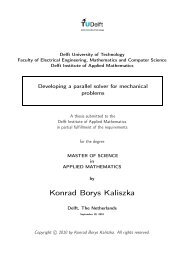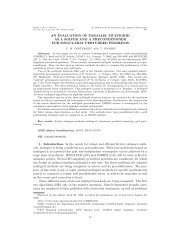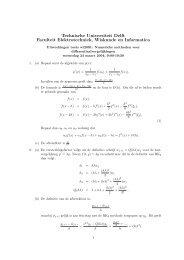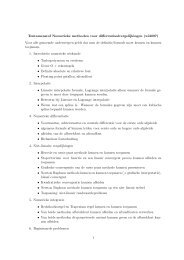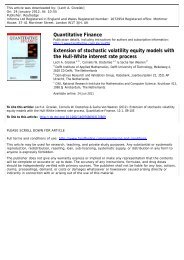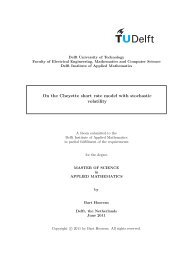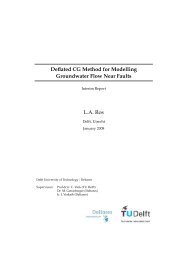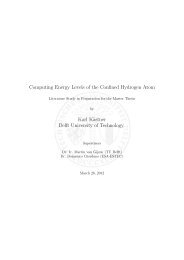Hydroelastic behavior of a floating ring-shaped plate
Hydroelastic behavior of a floating ring-shaped plate
Hydroelastic behavior of a floating ring-shaped plate
Create successful ePaper yourself
Turn your PDF publications into a flip-book with our unique Google optimized e-Paper software.
<strong>Hydroelastic</strong> <strong>behavior</strong> <strong>of</strong> a <strong>floating</strong> <strong>ring</strong>-<strong>shaped</strong> <strong>plate</strong>Alexey I. Andrianov (a.i.andrianov@ewi.tudelft.nl) and Aad J. Hermans(a.j.hermans@ewi.tudelft.nl)Department <strong>of</strong> Applied Mathematics,Faculty <strong>of</strong> Electrical Enginee<strong>ring</strong>, Mathematics and Computer Science,Delft University <strong>of</strong> Technology,Mekelweg 4, 2628 CD Delft, The NetherlandsReceived 26 July 2004; accepted in revised form 3 March 2005Abstract. The interaction between incident surface water waves and <strong>floating</strong> elastic <strong>plate</strong>s is studied.This paper considers the diffraction <strong>of</strong> plane incident waves on a <strong>floating</strong> flexible <strong>ring</strong>-<strong>shaped</strong> <strong>plate</strong>and its response to the incident waves. An analytic and numerical study <strong>of</strong> the hydroelastic <strong>behavior</strong><strong>of</strong> the <strong>plate</strong> is presented. An integro-differential equation is derived for the problem and an algorithm<strong>of</strong> its numerical solution is proposed. The representation <strong>of</strong> the solution as a series <strong>of</strong> Hankel functionsis the key ingredient <strong>of</strong> the approach. After an introduction, the problem is formulated. In Section 3the main integro-differential equation is on the basis <strong>of</strong> the Laplace equation and thin-<strong>plate</strong> theory.The free-surface elevation, <strong>plate</strong> deflection and Green’s function are expressed in polar coordinates asthe superpositions <strong>of</strong> Hankel and Bessel functions, respectively. These expressions, given in Section 4,are used in a further analysis <strong>of</strong> the integro-differential equation. The problem is solved for two cases<strong>of</strong> water depth: infinite and finite. For the coefficients in the case <strong>of</strong> infinite depth a set <strong>of</strong> algebraicequations is obtained, yielding an approximate solution in Section 6. Then a solution is obtained forthe general and most interesting case <strong>of</strong> finite water depth analogously in the seventh section. Theexact solution might be approximated by taking into account a finite number <strong>of</strong> the roots <strong>of</strong> the<strong>plate</strong> dispersion relation. Also, the influence <strong>of</strong> the <strong>plate</strong>’s motion on wave propagation in the openwater field and within the gap <strong>of</strong> the <strong>ring</strong> is studied. Numerical results are presented for illustrativepurposes.Key words: diffraction, hydroelastic response, integro-differential equation, <strong>plate</strong>-water interaction,<strong>ring</strong>-<strong>shaped</strong> <strong>plate</strong>.Abbreviations: VLFP – very large <strong>floating</strong> platform, IWD – infinite water depth, FWD – finitewater depth, IDE – integro-differential equation.1. Introduction and backgroundThis paper considers the hydroelastic <strong>behavior</strong> <strong>of</strong> a <strong>floating</strong> elastic <strong>plate</strong> and itsresponse to the incident surface water waves. A thin <strong>plate</strong> with elastic propertiesserves as a model for a very large <strong>floating</strong> platform (VLFP) designed for the purpose <strong>of</strong>an airport, ferry pier or other artificial construction, <strong>floating</strong> in <strong>of</strong>fshore zone. VLFPshave a mat-like dynamic <strong>behavior</strong> which can be described by the <strong>plate</strong> equation. Asthe horizontal dimensions <strong>of</strong> VLFP are about several kilometers by several hundredmeters, while the thickness and draft are <strong>of</strong> order <strong>of</strong> several meters, it is possible toconsider the platform as a thin <strong>plate</strong>, using one <strong>of</strong> the standard theories <strong>of</strong> Kirchh<strong>of</strong>f,Timoshenko or Mindlin. Such a <strong>plate</strong> can also serve as a model <strong>of</strong> a huge ice field forstudying ice-water interaction. Water depth plays an important role; therefore, thetheory is divided into three cases: very deep water (depth assumed to be infinite),water <strong>of</strong> finite depth, and shallow water.There are many papers conside<strong>ring</strong> <strong>plate</strong>-water interaction. For this problem verydetailed literature survey for this problem has recently been published by Watanabec○ 2005 Kluwer Academic Publishers. Printed in the Netherlands.AndrianovHermans.tex; 15/03/2005; 17:37; p.1
2 A.I. Andrianov & A.J. Hermanset al. [1]. Mainly <strong>plate</strong>s <strong>of</strong> rectangular planforms have been studied, while there arevery few papers conside<strong>ring</strong> arbitrarily <strong>shaped</strong> VLFPs. Several papers, studying thecircular <strong>plate</strong>, were published recently. The problem for the circular <strong>plate</strong> for shallowwater was solved by Zilman and Miloh [2] and Tsubogo [3]. For finite water depth theproblem was solved by Watanabe et al. [4] by use <strong>of</strong> the Galerkin method and Mindlin<strong>plate</strong> theory, and Peter et al. [5] who presented a solution based on decomposing thesolution into angular eigenfunctions. Andrianov and Hermans [6] solved the problem<strong>of</strong> the circular disk for water <strong>of</strong> finite and infinite depth, using an integro-differentialformulation.Here we extend the theory to the case <strong>of</strong> a <strong>ring</strong>-<strong>shaped</strong> <strong>plate</strong> (or, as in some <strong>of</strong>the literature, a circular <strong>plate</strong> with a circular hole). The <strong>floating</strong> structure <strong>of</strong> thisform may be either <strong>of</strong> large dimension, for purposes <strong>of</strong> VLFP, or small, for otherpurposes. The hydroelastic <strong>behavior</strong> <strong>of</strong> the <strong>ring</strong>-<strong>shaped</strong> <strong>floating</strong> elastic <strong>plate</strong> and itsresponse to incident surface waves are investigated. The <strong>ring</strong> floats on the surface <strong>of</strong>ideal, incompressible fluid. We consider two cases <strong>of</strong> water depth. First, we study the<strong>behavior</strong> <strong>of</strong> the <strong>ring</strong> <strong>floating</strong> on the surface <strong>of</strong> water <strong>of</strong> infinite depth. Next the case <strong>of</strong>water <strong>of</strong> finite depth is considered, where the general analysis and set <strong>of</strong> equations aremore complicated as more roots <strong>of</strong> a water dispersion relation have to be taken intoaccount. An analytical study is carried out and presented for both cases. The problemfor water <strong>of</strong> shallow depth can be solved more easily by the use <strong>of</strong> well-known Stokerapproximation theory. In the latter case a set <strong>of</strong> equations is derived from free-edgeand transition conditions at the inner and outer edges <strong>of</strong> the <strong>ring</strong>.An integro-differential formulation, which allows us to solve the diffraction problemfor different geometrical configurations, was developed and applied in [6–9]. Thisformulation might be applied to a <strong>plate</strong> <strong>of</strong> finite or infinite dimensions and even tothe case <strong>of</strong> multiple <strong>plate</strong>s. Also the thin <strong>plate</strong> theory, standard Laplace equation inthe fluid, supplemented by surface and boundary conditions, and Green’s theoremare used.We consider a <strong>plate</strong> having elastic properties <strong>of</strong> constant flexural rigidity andhomogeneous stiffness. The edges <strong>of</strong> the <strong>ring</strong> are free <strong>of</strong> shear forces, bending andtwisting moments. The <strong>plate</strong> deflection is generated by incoming plane surface waves.The solution for the <strong>plate</strong> deflection and free-surface elevation in the far field and<strong>ring</strong> gap is derived. The <strong>plate</strong> deflection is represented as a superposition <strong>of</strong> Hankelfunctions with corresponding coefficients, containing amplitudes. In a similar way, werepresent the Green’s function, obeying the boundary conditions at the free surface,as a series <strong>of</strong> Bessel functions for both cases <strong>of</strong> water depth. Further, Graf’s additiontheorem is applied to the Green’s function.Next, we derive the governing integro-differential equation. The problem involvestwo dispersion relations: one in the <strong>plate</strong> region and the other in the open water.An analysis <strong>of</strong> integrals in the complex plane and use <strong>of</strong> Cauchy’s theorem and theWronskian lead us to the dispersion relation in the <strong>plate</strong> region. Furthermore, we derivefrom the integro-differential equation, supplemented by the free-edge conditions,a set <strong>of</strong> equations for the coefficients in the series expansion to determine the <strong>plate</strong>deflection. Also, we study the free-surface elevation in the <strong>ring</strong> gap and in the openwater field. To analyze the influence <strong>of</strong> the presence <strong>of</strong> the <strong>plate</strong> on the propagation<strong>of</strong> the incoming waves, results are obtained for the wave pattern generated by theAndrianovHermans.tex; 15/03/2005; 17:37; p.2
<strong>Hydroelastic</strong> Behavior <strong>of</strong> a Floating Ring-Shaped Plate 3<strong>plate</strong>’s motion. Numerical results are obtained for different values <strong>of</strong> the physicalparameters for the <strong>plate</strong> deflection and the free-surface elevation.2. Mathematical formulationA <strong>floating</strong> thin elastic <strong>ring</strong>-<strong>shaped</strong> <strong>plate</strong> <strong>of</strong> inner radius r 1 and outer radius r 0 coversa part <strong>of</strong> the surface <strong>of</strong> an ideal, incompressible expanse <strong>of</strong> water. The <strong>plate</strong> with zerothickness can serve as a model <strong>of</strong> the VLFP, as described above, due to the smallthickness and shallow draft <strong>of</strong> the platform. The water depth h is infinite for the case<strong>of</strong> deep water and finite and constant for the other case. We assume that no spaceexists between the free surface and the <strong>plate</strong>. The flexural rigidity <strong>of</strong> the thin elasticisotropic <strong>plate</strong> is constant.The <strong>plate</strong> deflection is generated by incoming surface waves <strong>of</strong> length λ. It is alsoassumed that incoming waves are propagating in water that is still homogeneous inthe positive x-direction. The wave amplitude A is rather small in comparison withother length-parameters <strong>of</strong> the problem.The horizontal geometry sketch <strong>of</strong> the <strong>plate</strong> is shown in Figure 1. The radialcoordinate ρ is measured from the centre <strong>of</strong> the <strong>plate</strong>. We denote the surface <strong>of</strong> thefluid domain in the <strong>plate</strong> region (r 1 ≤ ρ ≤ r 0 ) as P and in the open water as F,where the open-water region outside the <strong>plate</strong> is F 0 (ρ > r 0 ) and the gap area F 1(ρ < r 1 ). Three-dimensional Laplacian is∆ = ∇ 2 = ∂2∂ρ 2 + 1 ∂ρ ∂ρ + 1 ∂ 2ρ 2 ∂ϕ 2 + ∂2∂z 2in polar coordinates, while their relations to Cartesian coordinates are the following:ρ 2 = x 2 + y 2 , ϕ = arctan y/x, z = z.yr 0r 1PSfrag replacementsϕρxz (up)Figure 1. Geometry and coordinate system <strong>of</strong> the problem.The velocity potential is introduced by ∇Φ(ρ, t) = V(ρ, t), where V(ρ, t) is thefluid velocity vector. The velocity potential Φ(ρ, t) is a solution <strong>of</strong> the governingLaplace equation in the fluid∆Φ = 0, (1)AndrianovHermans.tex; 15/03/2005; 17:37; p.3
4 A.I. Andrianov & A.J. Hermansfor z < 0 in the case <strong>of</strong> infinite water depth (IWD) or −h < z < 0 for finite waterdepth (FWD), supplemented by the boundary conditions at the free surface and atthe bottom for FWD. The linearized kinematic condition in the <strong>plate</strong> and waterregions, at the surface z = 0, has the form∂Φ∂z = ∂w∂t , (2)where w(ρ, ϕ, t) denotes either the free-surface elevation or the deflection <strong>of</strong> the <strong>plate</strong>;t is the time. Later, to distinguish the vertical displacements, we denote the freesurfaceelevation in the open water region F by ζ, while the <strong>plate</strong> deflection in Pis still denoted by w. The dynamic condition, derived from the linearized Bernoulliequation, has the formP − P atmρ w= − ∂Φ∂t− gw, (3)at z = 0, where ρ w is the density <strong>of</strong> the water, g is the gravitational acceleration,P (ρ, ϕ, t) is the pressure in the fluid, and P atm is the atmospheric pressure. Relations(2–3) are the kinematic and dynamic conditions at the free surface. The linearizedfree-surface condition in the water region F takes the form∂Φ∂z = −1 ∂ 2 Φg ∂t 2 (4)at z = 0. The other boundary condition at the bottom z = −h, applying for the case<strong>of</strong> finite depth, is written in the following form∂Φ∂z= 0. (5)The edges <strong>of</strong> the <strong>ring</strong> are free <strong>of</strong> vertical shear forces, bending and twistingmoments. Therefore, the free-edge conditions at ρ = r 1 and ρ = r 0 are:{(∇ 2 (1 − ν) ∂−ρ ∂ρ + 1 )}∂ 2ρ ∂ϕ 2 w = 0, (6){ ( ∂ (1 − ν) ∂∂ρ ∇2 +ρ 2 ∂ρ − 1 ) }∂2ρ ∂ϕ 2 w = 0, (7)where ν is the Poisson ratio. Here and in the sequel the Laplacian is two-dimensional,except when the Green’s function is derived.3. Integro-differential equationIn this section the main integro-differential equation (IDE) is derived along the <strong>plate</strong>contour, consisting <strong>of</strong> the inner and outer edges <strong>of</strong> the <strong>ring</strong>. We use the approachdescribed and applied in [7–8] for <strong>plate</strong>s <strong>of</strong> rectangular shape in Cartesian coordinates.The derivation <strong>of</strong> IDE in polar coordinates has recently been published by the authors[6].AndrianovHermans.tex; 15/03/2005; 17:37; p.4
<strong>Hydroelastic</strong> Behavior <strong>of</strong> a Floating Ring-Shaped Plate 5To describe the deflection <strong>of</strong> the <strong>plate</strong> w we apply the isotropic thin-<strong>plate</strong> theory,see, e.g., [10], which leads to a differential equation at z = 0 in the <strong>plate</strong> area P,known as the Geh<strong>ring</strong>-Kirchh<strong>of</strong>f equationD∆ 2 w + m ∂2 w∂t 2 = P − P atm, (8)where m is the mass <strong>of</strong> an unit area <strong>of</strong> the <strong>plate</strong>, D is the flexural rigidity, expressedin terms <strong>of</strong> Young’s modulus E, Poisson ratio ν and the <strong>plate</strong> thickness h p :D =Eh 3 p12(1 − ν 2 ) .For both IWD and FWD cases we apply the operator ∂/∂t to (8) and use the surfaceconditions (2) and (3) to arrive at the following equation for the total potential Φ(Dρ w g ∆2 + mρ w g∂ 2∂t 2 + 1 )∂Φ∂z + 1 g∂ 2 Φ= 0. (9)∂t2 With the usual assumptions <strong>of</strong> an ideal fluid and small wave amplitude, thepotential can be written in the form Φ(ρ, ϕ, z, t) = φ(ρ, ϕ, z)e −iωt , where ω is thewave frequency; this means we consider harmonic waves. From (2) it follows thatthe surface elevation has the same harmonic <strong>behavior</strong>, whence we have the functionsw(ρ, ϕ) and ζ(ρ, ϕ) in P and F, respectively. Thus, we consider waves <strong>of</strong> the singlefrequency ω and obtain the following differential equation for the potential φ at z = 0() ∂φD∆ 2 − µ + 1 − Kφ = 0, (10)∂zwhere D = D/ρ w g, µ = mω 2 /ρ w g are additional physical parameters that areconstant as the <strong>plate</strong> considered is isotropic, and K = ω 2 /g.The potential <strong>of</strong> the undisturbed incident wave φ inc , in polar coordinates, is⎧gA⎪⎨ iω eik 0ρ cos ϕ+k 0 zfor IWD,φ inc (ρ, ϕ, z) =⎪⎩cosh k 0 (z + h)cosh k 0 hgAiω eik 0ρ cos ϕfor FWD,where A is the amplitude <strong>of</strong> the incident wave, and k 0 is the wave number. Thewave height is defined as twice the amplitude. For deep water the wave number isk 0 = K and for water <strong>of</strong> finite depth wave number k 0 is the positive real solution <strong>of</strong>the water-dispersion relation(11)k tanh kh = K. (12)The length <strong>of</strong> the incoming waves is λ = 2π/k 0 . Normally, in a practical situationthe outer diameter 2r 0 <strong>of</strong> the <strong>ring</strong>-<strong>shaped</strong> VLFP is longer than the wave length; thereverse case corresponds to extremely long waves.The potential must satisfy the Sommerfeld radiation condition√ ρ( ∂∂ρ − ik 0) (φ − φ inc) = 0 (13)AndrianovHermans.tex; 15/03/2005; 17:37; p.5
6 A.I. Andrianov & A.J. Hermanswhen ρ → ∞.The free-surface elevation ζ in the open water F equals to the sum <strong>of</strong> the incidentwave elevation ζ inc , and the additional wave elevation ζ pm , generated by the <strong>plate</strong>motionζ = ζ inc + ζ pm . (14)The total potential in F is also represented as the sum <strong>of</strong> the incident wave potentialand the potential <strong>of</strong> waves arising because <strong>of</strong> the presence <strong>of</strong> the <strong>plate</strong>φ F = φ inc + φ pm , (15)where φ pm is the diffraction potential plus the radiation potential. In fact, the potentialfunction φ pm must satisfy radiation condition (13). The governing equationsfor the regions F 0 and F 1 are the same; due to the fact that ρ > r 0 and ρ < r 1 ,respectively, differences in the analysis will appear, which will be discussed later.We introduce the Green’s function G(r, θ; ρ, ϕ), fullfilling the free-surface and theradiation conditions, and apply Green’s theorem to the potentials in the water and<strong>plate</strong> regions φ F and φ P , respectively. Analyzing the obtained relations and using thedynamic (10) and kinematic (2) conditions, we obtain the main integro-differentialequation in general form at the free surface z = 0{}D∆ 2 − µ + 1 w(ρ, ϕ)= K ∫{ }G(r, θ; ρ, ϕ) D∆ 2 − µ w(r, θ) r dr dθ + Ae ik 0ρ cos ϕ , (16)4πPwhere the last term represents the potential <strong>of</strong> the incoming waves. The presentedderivation <strong>of</strong> IDE can be done in polar and Cartesian coordinates, i.e., for <strong>plate</strong>s <strong>of</strong>any geometrical shape. Detailed information on the derivation <strong>of</strong> IDE is given in [6]for polar coordinates and in [7–8] for Cartesian coordinates.4. Green’s function and deflectionIn this section we describe the Green’s function, <strong>plate</strong> deflection and the operationson corresponding Bessel and Hankel functions for the <strong>ring</strong>-<strong>shaped</strong> <strong>plate</strong>. The generalexpressions for the Green’s function <strong>of</strong> a surface singularity for water <strong>of</strong> infinite andfinite depth can be found in [11]. The description <strong>of</strong> the modified Green’s function,which is used in this paper, was published by the authors in [6].We introduce the Green’s function for a source within the fluid that in Cartesiancoordinates fulfills ∆G = 4πδ(x − ξ), where δ is the Dirac δ-function, x is a sourcepoint and ξ is an observation point. The Green’s function obeys the boundary conditionsat the free surface, G z = KG, and at the bottom as well as the radiationcondition. The three-dimensional Green’s function at z = ζ = 0 takes the followingform [6]∫G(x, y; ξ, η) = −2 F (k)J 0 (kR) dk, (17)LAndrianovHermans.tex; 15/03/2005; 17:37; p.6
<strong>Hydroelastic</strong> Behavior <strong>of</strong> a Floating Ring-Shaped Plate 7where J 0 (kR) is the Bessel function, R measures horizontal distance, viz. R 2 = (x −ξ) 2 + (y − η) 2 in Cartesian coordinates. L is the integration contour in the complexk-plane from 0 to +∞, passing beneath the singularity k = k 0 , as shown in Figure 2,and chosen such that the radiation condition is satisfied. The function F (k) in (17)is given by⎧kfor IWD, (a)⎪⎨ k − k 0F (k) =⎪⎩k cosh khk sinh kh − K cosh khfor FWD,In the PSfrag FWD case replacements we have additional poles k = ±k i on the imaginary axis <strong>of</strong> thecomplex plane.0k 0k(b).(18)Figure 2. Contour <strong>of</strong> the integration.LThe horizontal distance R in polar coordinates is written as R 2 (ρ, ϕ; r, θ) = ρ 2 +r 2 − 2ρr cos (θ − ϕ). Here ρ and r are the distances from the center <strong>of</strong> the <strong>plate</strong> tothe source and observation points respectively, and θ − ϕ is the angle between r andρ.If we apply Graf’s addition theorem to the Bessel function J 0 (kR), which is alsocalled Neumann’s formula for the Bessel function <strong>of</strong> order zero, it can be replaced bythe series [12]∞∑J 0 (kR) = δ q J q (kr)J q (kρ) cos q(θ − ϕ), (19)q=0where δ 0 = 1 and δ q = 2 if q > 0. We truncate the series in (19) at q = N, chosensuch that convergence <strong>of</strong> the final results is guaranteed and taking into account thedecaying <strong>behavior</strong> <strong>of</strong> the Bessel functions with respect to the order. The value <strong>of</strong> N ischosen later; all terms <strong>of</strong> order higher than N are negligibly small. This is justified byinvoking a computational test. The Green’s function in polar coordinates now takesthe form∫G(r, θ; ρ, ϕ) = −2LN∑F (k) δ q J q (kr)J q (kρ) cos q(θ − ϕ) dk. (20)q=0In the sequel we use the Green’s function in the form (20).At the same time the deflection function has to be chosen for each shape <strong>of</strong> the <strong>plate</strong>separately. For the circular <strong>plate</strong> it can be expressed by the superposition <strong>of</strong> Besselfunctions [6]. Analogously, for the <strong>ring</strong>-<strong>shaped</strong> <strong>plate</strong> the deflection can be representedas a series <strong>of</strong> Hankel functions with corresponding coefficients <strong>of</strong> the following formw(ρ, ϕ) =M∑N∑m=1 n=0[]a (1)mnH (1)n (κ m ρ) + a (2)mnH (2)n (κ m ρ) cos nϕ, (21)AndrianovHermans.tex; 15/03/2005; 17:37; p.7
8 A.I. Andrianov & A.J. Hermanswhere a (1)mn and a (2)mn are unknown amplitude functions, κ m are the roots <strong>of</strong> the <strong>plate</strong>dispersion relation, which are the so-called reduced wave numbers, and M is thenumber <strong>of</strong> these roots taken into account in the computations.For the IWD case we use three roots <strong>of</strong> the dispersion relation in the <strong>plate</strong> area()Dκ 4 − µ + 1 κ = ±k 0 . (22)The roots <strong>of</strong> the <strong>plate</strong> dispersion relation (22), shown in Figure 3, are the following:two real roots ±κ 1 , and four complex roots ±κ 2 and ±κ 3 , which are symmetricallyplaced with respect to both the real and imaginary axes. Due to a property <strong>of</strong> Hankelfunctions, three roots are taken into account for the current situation: real positiveκ 1 and roots κ 2 and κ 3 , with equal imaginary parts and equal, but opposite-signedreal parts, all three being located in the upper half-plane. The real root κ 1 representsthe main traveling wave mode, the two complex roots represent damped waves.PSfrag replacementsκ 3κ 2κ 1−κ 1−κ 2 −κ 3Figure 3. Zeros <strong>of</strong> the dispersion relation for deep water.The <strong>plate</strong> dispersion relation for water <strong>of</strong> finite depth has the following form()Dκ 4 − µ + 1 κ tanh κh = K. (23)The dispersion relation (23) has two real roots ±κ 1 , and four complex roots ±κ 2 and±κ 3 symmetrically placed with respect to both the real and imaginary axes, thesesix being <strong>of</strong> the same order as in the IWD case, and infinitely many purely imaginaryroots. We take into account M roots <strong>of</strong> Equation (23): one real positive κ 1 , twocomplex roots κ 2 and κ 3 , having imaginary parts and equal but opposite-signed realparts, and M − 3 imaginary roots, all located in the upper half-plane.The positions <strong>of</strong> the roots κ m in the complex k-plane are similar to those <strong>of</strong> theroots <strong>of</strong> the water dispersion relation (12), which has one real root k 0 , correspondingto only one wave number <strong>of</strong> deep water, and a number <strong>of</strong> purely imaginary roots k i ,i = 1, ..., M −3, except for two complex roots κ 2 and κ 3 . Thus, in the FWD case M isthe truncation parameter, and we take into account M roots <strong>of</strong> the <strong>plate</strong> dispersionrelation (23) κ m , m = 1, ..., M, and M − 2 roots <strong>of</strong> the water dispersion relation (12)k i , i = 0, ..., M − 3.AndrianovHermans.tex; 15/03/2005; 17:37; p.8
<strong>Hydroelastic</strong> Behavior <strong>of</strong> a Floating Ring-Shaped Plate 95. Set <strong>of</strong> equationsAt this point we have only equations resulting from the free-edge conditions to determinethe unknown amplitudes a (1)mn and a (2)mn. Next we will derive relations from theintegro-differential equation to complete the set <strong>of</strong> equations.If we insert the relations for the deflection (21) and Green’s function (20) into(16), the integro-differential equation at the free surface z = 0 takes the expandedform{} M [D∆ 2 ∑ ∑ N− µ + 1 a (1)mn H(1) n (κ mρ) cos nϕ +m=1 n=0∫2π∫ r 0N∑a (2)mn H(2) n (κ mρ) cos nϕn=0+ K { } M [D∆ 2 ∑ N]∑N∑− µ a (1)2πmnH (1)n (κ m r) cos nθ + a (2)mnH (2)n (κ m r) cos nθ0 r 1m=1 n=0n=0∫ N∑N∑× F (k) δ q J q (kr)J q (kρ) cos q(θ − ϕ) dk r dr dθ = A ɛ n J n (k 0 ρ) cos nϕ, (24)Lq=0n=0where ɛ n = δ n i n . Due to the orthogonality relation for the cosine function, we onlyget a non-zero contribution in the integrand for n = q. Next we carry out the integrationwith respect to θ in (24). The integration over θ itself, when only componentsdependent on θ are considered, gives 2π for n = 0 and δ n π cos nϕ for n > 0, whichmeans 2π cos nϕ for all n. Then, using the orthogonality <strong>of</strong> the cosine function, weend up with the following set <strong>of</strong> N + 1 equations derived from IDE (24):M∑+Kr 1) [](Dκ 4 m − µ + 1 a (1)mn H(1) n (κ mρ) + a (2)mn H(2) n (κ mρ)m=1∫ r 0∑ Mm=1∫×L) [](Dκ 4 m − µ a (1)mn H(1) n (κ mr) + a (2)mn H(2) n (κ mr)F (k)J n (kr)J n (kρ) dk r dr = Aɛ n J n (k 0 ρ), (25)for n = 0, ..., N. In accordance with [13, Equation 21.8-22] the integration with respectto r leads us to the difference <strong>of</strong> two Lommel integrals at r 0 and r 1 . Equation (25)takes the form]∫+KLM∑m=1M∑m=1) [](Dκ 4 m − µ + 1 a (1)mn H(1) n (κ mρ) + a (2)mn H(2) n (κ mρ)(Dκ 4 m − µ ) F (k)(k 2 − κ 2 m)[]a (1)mn c(1) mn + a(2) mn c(2) mn J n (kρ) dk = Aɛ n J n (k 0 ρ),(26)AndrianovHermans.tex; 15/03/2005; 17:37; p.9
10 A.I. Andrianov & A.J. Hermanswhere we have introduced the function c (q)mn as a combination <strong>of</strong> Bessel and Hankelfunctions in the formc (q)mn = r 0[−r 1[kJ n+1 (kr 1 )H (q)kJ n+1 (kr 0 )H (q)nn(κ mr 0 ) − κ m J n (kr 0 )H (q) ]n+1 (κ mr 0 )], q = 1, 2. (27)(κ mr 1 ) − κ m J n (kr 1 )H (q)n+1 (κ mr 1 )From Equation (26) we can derive 2(M −2)(N +1) relations for the determination<strong>of</strong> 2M(N +1) unknown amplitudes. The set <strong>of</strong> equations for both cases <strong>of</strong> water depthis completed by the free-edge conditions (6–7) when the deflection function is insertedthere. These conditions at the edges ρ = r 1 and ρ = r 0 give us 4(N + 1) equationsM∑m=1a (1)mn d(1) mn,ij + a(2) mn d(2) mn,ij = 0, (28)where n = 0, ..., N, i = 0, 1, j = 1, 2, and the functions d (q)[()d (q)mn,i1 = H (q)n (κ mr i ) −κ 2 (1 − ν)n(n − 1)m +r 2 imn,ij are[(d (q)mn,i2 = H (q)n (κ m r i ) − n κ 2 m + (1 − ν)n2 (1 − n)r i(+ H (q)n+1 (κ mr i ) κ 3 m +]+ H (q)n+1 (κ (1 − ν)mr i )κ m ,r i)r 3 i)](1 − ν)n2ri2 κ m , (29)where q = 1, 2 is the Hankel-function index and r i is either inner-<strong>ring</strong> contour r 1 orouter-<strong>ring</strong> contour r 0 .From now on we consider the IWD and FWD cases separately.6. Ring on water <strong>of</strong> infinite depthHere the analytic study is given for the case <strong>of</strong> infinite depth. In the IWD case we onlyconsider part <strong>of</strong> the solution, namely that related to the water dispersion relation.The analysis given in this section is a good basis from which to derive a solution forthe general and most complicated case <strong>of</strong> water <strong>of</strong> finite depth. To demonstrate themethod we wish to use for the FWD case, we consider the contribution <strong>of</strong> the polek = k 0 in the IWD case. Here we ignore the contribution <strong>of</strong> the integral along theimaginary axis after closing the contour in (20). This means that local disturbancesare disregarded.The deflection <strong>of</strong> the <strong>plate</strong>, the Green’s function and the function F (k) are representedby expressions (21), (20) and (18a), respectively. For deep-water wave numberk 0 equals K, so k 0 = ω 2 /g.Now we analyze the k-integral in IDE (26). The integrand has the poles k = ±κ m ,shown in Figure 3, and can be represented as a sum <strong>of</strong> four integrals∫∞k 00k(k − k 0 )(k 2 − κ 2 m)[]a (1)mn c(1) mn + a(2) mn c(2) mn J n (kρ) dk= a (1)mn (I 01 − I 11 ) + a (2)mn (I 02 − I 12 ) , (30)AndrianovHermans.tex; 15/03/2005; 17:37; p.10
<strong>Hydroelastic</strong> Behavior <strong>of</strong> a Floating Ring-Shaped Plate 11where the path <strong>of</strong> integration in (31) is below the singularities k = k 0 and k = κ 1 ,respectively, and the integrals I iq for i = 0, 1, q = 1, 2 are[×kJ n+1 (kr i )H (q)n∫∞I iq = k 0 r i0k(k − k 0 )(k 2 − κ 2 m)(κ m r i ) − κ m J n (kr i )H (q)n+1 (κ mr i )]J n (kρ) dk, (31)with r i as r 1 or r 0 , m = 1, ..., M and n = 0, ..., N. The contour <strong>of</strong> integration may beclosed in the complex k-plane. In the integral I iq we split up the Bessel function <strong>of</strong>largest argument to be able to close the contour <strong>of</strong> integration and, furthermore, useJordan’s lemma.Let us consider the integral I 01 . For further manipulation we use the fact that ρ r 1 and, therefore, to close the contours <strong>of</strong> integration we represent the Besselfunctions J n (kρ) as the half-sums <strong>of</strong> corresponding Hankel functions <strong>of</strong> the first andsecond kind, as was done in (32).When the contours are closed for all integrals, we apply the Cauchy residue lemmaat the poles k = κ m for the integrals with the contour closed in the upper half-planeand at the poles k = −κ m for the integrals with the contour closed in the lowerhalf-plane. The Wronskian W {H (1)n (κ m r i ), H (2)n (κ m r i ) applies for the combination <strong>of</strong>Hankel functionsH (1)n+1 (κ mr i )H (2)n (κ mr i ) − H (1)n (κ mr i )H (2)n+1 (κ mr i ) = − 4i . (33)πκ m r iThen, adding up the resulting terms and conside<strong>ring</strong> the coefficients <strong>of</strong> J n (κr i ), wederive the <strong>plate</strong> dispersion relation for deep water (22), where the plus sign in theright-hand side corresponds to the integrals in the upper half-plane, and the minussign to the integrals in the lower half-plane. The derivation <strong>of</strong> the <strong>plate</strong> dispersionrelation from IDE is also a justification <strong>of</strong> our approach.In the upper half-plane we also obtain a contribution <strong>of</strong> the pole k = k 0 <strong>of</strong> theintegrand, as seen in Figure 2. This contribution has to cancel the term in the righthandside <strong>of</strong> IDE (26). If we neglect the integral along the imaginary axis, applicationAndrianovHermans.tex; 15/03/2005; 17:37; p.11
12 A.I. Andrianov & A.J. Hermans<strong>of</strong> Jordan’s lemma and the contribution <strong>of</strong> the pole k = k 0 lead us to 2(N +1) relationsandπir 0πir 1M ∑m=1M ∑m=1( )Dκ 4 k02m − µk 2 0 − κ2 m[k 0 H (1) ()n+1 (k 0r 0 ) a (1)mnH (1)n (κ m r 0 ) + a (2)mnH (2)n (κ m r 0 )()]−κ m H (1)n (k 0r 0 ) a (1)mn H(1) n+1 (κ mr 0 ) + a (2)mn H(2) n+1 (κ mr 0 )( )Dκ 4 k02m − µ−κ m J n (k 0 r 1 )k 2 0 − κ2 m= Aɛ n (34)[()k 0 J n+1 (k 0 r 1 ) a (1)mnH (1)n (κ m r 1 ) + a (2)mnH (2)n (κ m r 1 )()]a (1)mn H(1) n+1 (κ mr 1 ) + a (2)mn H(2) n+1 (κ mr 1 )= 0. (35)We have now derived a system <strong>of</strong> 2M(N + 1) equations (34–35) and (28) withM = 3 for the determination <strong>of</strong> 2M(N + 1) amplitudes a (1)mn and a (2)mn for ’infinitely’deep water. When the amplitudes are known, the <strong>plate</strong> deflection is calculated by(21).7. Ring on water <strong>of</strong> finite depthIn this section we consider a <strong>ring</strong> on water <strong>of</strong> finite depth. In general we follow theanalysis as presented in the previous section for the IWD case. For the FWD casethe deflection <strong>of</strong> the <strong>plate</strong> is represented by (21) and the Green’s function is givenby formulas (20) and (18b). Here we take into account M − 2 roots <strong>of</strong> the waterdispersion relation (12) and M roots <strong>of</strong> the <strong>plate</strong> dispersion relation (23).Let us consider the function F (k) given by (18b). For the FWD case this functionis meromorphic, as it is bounded for all poles. The poles are the roots <strong>of</strong> the dispersionrelation for the water region (12) k = ±k i , i = 0, ..., M − 3, where k 0 is the positivereal root and k i , for i ≠ 0, is the purely imaginary. So, the meromorphic functionF (k) for water <strong>of</strong> finite depth can be expressed by the following relationF (k) =M−3 ∑i=0ki2 ( 1ki 2h − + 1 ). (36)K2 h + K k + k i k − k iThe relation (36) is inserted into IDE (26). There are two integrals in the complexk-plane, those two can be combined into one integral from −∞ to +∞ with the polesk = k i . The contour <strong>of</strong> integration is defined as L ′ . Finally, we derive the governingintegro-differential equation for the case <strong>of</strong> finite water depthM∑m=1() [] ∫Dκ 4 m − µ + 1 a (1)mnH (1)n (κ m ρ) + a (2)mnH (2)n (κ m ρ) + K× J M−3n(kρ) ∑k 2 [i(k 2 − κ 2 m) (k 2 i=0 i h − a (1)K2 h + K)(k − k i )mnc (1)mn + a (2)M ∑L ′ m=1]mnc (2)mn( )Dκ 4 m − µdk = Aɛ n J n (k 0 ρ)(37)AndrianovHermans.tex; 15/03/2005; 17:37; p.12
<strong>Hydroelastic</strong> Behavior <strong>of</strong> a Floating Ring-Shaped Plate 13at z = 0, where n = 0, ..., N and the functions c (q)mn are given by (27) for q = 1, 2.To obtain the dispersion relation we repeat the procedure that was applied for theIWD case: the representation <strong>of</strong> k-integral as a sum <strong>of</strong> four integrals and, further,decomposition <strong>of</strong> each <strong>of</strong> those four as two integrals with contours closed in thedifferent half-planes <strong>of</strong> the complex plane. In the FWD case we have the poles, given inFigure 3, plus the poles at the imaginary axis ±κ m for m = 4, ..., M. The application<strong>of</strong> the residue lemma at the poles leads us to the standard <strong>plate</strong> dispersion relationfor water <strong>of</strong> finite depth (23).We consider the contributions <strong>of</strong> the poles <strong>of</strong> the water dispersion relation (12).The closure <strong>of</strong> the contour is shown in Figure 4. The contour for the integrals with(kr i ) might be closed in the upper half-plane, while the contour for the integralswith H (2)q (kr i ) in the lower half-plane. In the latter case we get a zero contributionbecause the poles k = k i are located as indicated in Figure 4.H (1)qPSfrag replacementsk i0kFigure 4. Closure <strong>of</strong> the contour <strong>of</strong> the integration in the upper half-plane.An application <strong>of</strong> the Cauchy theorem to the integrals with the contour closed inthe upper half-plane gives us equations to determine the amplitudes a (1)mn and a (2)mn.The poles k = k i , where i = 0, ..., M − 3, result in 2(M − 2)(N + 1) equations. First(M − 2)(N + 1) equations are derived along the outer <strong>ring</strong> edge ρ = r 0 and have thefollowing form[× k i H (1)−κ m H (1)n (k i r 0 )n+1 (k ir 0 )k 0M (∑ Dκ4πiKr m − µ ) ki2 0(k 2 m=1 i − κ2 m)(ki 2h − K2 h + K)(a (1)mn H(1) n (κ mr 0 ) + a (2)mn H(2)(a (1)mnH (1)n+1 (κ mr 0 ) + a (2)mnH (2)n+1 (κ mr 0 ))n (κ mr 0 ))]= A i , (38)whereA i ={ Aɛn , i = 0,0, i = 1, ..., M − 3,as the case i = 0 corresponds to the pole k = k 0 . The remaining (M − 2)(N + 1)equations are derived along the inner edge <strong>of</strong> the <strong>ring</strong> ρ = r 1[×M (∑ Dκ4πiKr m − µ ) ki2 1(k 2 m=1 i − κ2 m )(k2 i h − K2 h + K)(k i J n+1 (k i r 1 ) a (1)mnH (1)n (κ m r 1 ) + a (2)mnH (2)−κ m J n (k i r 1 )(a (1)mnH (1)n+1 (κ mr 1 ) + a (2)mnH (2)n+1 (κ mr 1 ))n (κ m r 1 ))]= 0. (39)AndrianovHermans.tex; 15/03/2005; 17:37; p.13
14 A.I. Andrianov & A.J. HermansWe have derived now 2(M −2)(N +1) relations (38–39) to determine the unknownamplitudes. The set <strong>of</strong> equations, like in the previous section, is completed by 4(N +1)edge conditions (28). The deflection can now be computed by (21).The finite water-depth model can be used to solve the problem <strong>of</strong> shallow orinfinitely deep water. Taking the limits we can derive the solutions for these situationsincluding transition from the dispersion relation for water <strong>of</strong> finite depth to thedispersion relations for deep and shallow water, respectively.8. Free-surface elevation and initiated wave patternWe continue the analysis <strong>of</strong> the <strong>plate</strong>-water interaction and consider the open waterregions, that is the main region F 0 and the gap inside the <strong>ring</strong> F 1 . The elevationζ(ρ, ϕ) <strong>of</strong> the free surface can be computed by (14), where the value <strong>of</strong> ζ inc may beobtained from the incident wave potential expression (11) by use <strong>of</strong> the kinematiccondition (2) and the value <strong>of</strong> ζ pm from the following analysis <strong>of</strong> IDE in the waterarea.The integro-differential equation has the form (37) for the FWD case. Therefore,we obtain the following expression for the free-surface elevation∫ζ(ρ, ϕ) = Ae ik 0ρ cos ϕ − KM−3 ∑×i=0L ′M ∑m=1k 2 i(k 2 i h − K2 h + K)(k − k i )( )Dκ 4 Jn (kρ)m − µ(k 2 − κ 2 m )[a (1)mnc (1)mn + a (2)]mnc (2)mndk. (40)We notice that in the open water region F 0 , where ρ > r 0 > r 1 , J n (kρ) is split upinto a half-sum <strong>of</strong> corresponding Hankel functions to close the contour <strong>of</strong> integration,and, to do so at the gap area F 1 , the Bessel functions J t (kr 1 ), t = n, n + 1, are splitup for ρ < r 1 < r 0 . Finally, after using <strong>of</strong> the residue lemma at the poles k = k i , weobtain for the free-surface elevationζ(ρ, ϕ) = Ae ik 0ρ cos ϕ − πiM∑m=1( )Dκ 4 m − µM−3 ∑ki 2 ×K[(k 2 i=0 i h − K2 h + K)(ki 2 − κ2 m ) a (1)mn f (1)mni + a(2) mn f (2) ]mni, (41)where the functions f (q)mni have the following expressions in the open water F 0 and inthe gap F 1f (q)mni = ⎧⎨⎩[r 0 H (1)n (k i ρ)r 1 J n (k i ρ)kJ n+1 (k i r 0 )H (q)n[kH (1)n+1 (k ir 1 )H (q)(κ m r 0 ) − κ m J n (k i r 0 )H (q) ]n+1 (κ mr 0 )n (κ mr 1 ) − κ m H (1)n (k ir 1 )H (q) ]n+1 (κ mr 1 )in F 0 ,in F 1 ,for q = 1, 2 and i = 0, ..., M − 3.For infinitely deep water the procedure, in general, is the same, but with the polek = k 0 <strong>of</strong> the water dispersion relation only. We derive the following equation for the(42)AndrianovHermans.tex; 15/03/2005; 17:37; p.14
free-surface elevationζ(ρ, ϕ) = Ae ik 0ρ cos ϕ − πi<strong>Hydroelastic</strong> Behavior <strong>of</strong> a Floating Ring-Shaped Plate 15M∑m=1( )Dκ 4 k 2 [0m − µ(k0 2 − a (1)mnf (1)κ2 mn0m)+ a(2) mnf (2) ]mn0 , (43)where the functions f (q)mn0 , q = 1, 2, are defined by formula (42), for i = 0, for thewater regions F 0 and F 1 .The expressions (41) and (43) are for the total free-surface elevation for the FWDand IWD cases. We can subtract the incident field and use the second terms in theright-hand sides <strong>of</strong> these expressions, representing ζ pm , to study the resulting wavepattern as generated by the <strong>plate</strong> motion.9. Numerical resultsIn this section numerical results are given for the title problem for both the IWDand the FWD models. Results are presented for relevant and practically importantcases. We show results for the <strong>plate</strong> deflection w, free-surface elevation ζ and initiatedwave pattern elevation ζ pm , normalized by the wave amplitude A. Calculations arebased on the varied flexural rigidity D, while the <strong>plate</strong> radii r 1 and r 0 , Poisson ratioν = 0·25 and ratio m/ρ w = 0·25 m are constant. The wave amplitude is A = 1 m,water depth and incident wave length are varied, leading to different values <strong>of</strong> wavenumber k 0 and, respectively, <strong>of</strong> the frequency ω. In all given figures the values <strong>of</strong> theinner and outer radii are the following: r 1 = 100 m and r 0 = 500 m.The number <strong>of</strong> the roots <strong>of</strong> the <strong>plate</strong> dispersion relation that are taken into accountfor the FWD case is M = 10. The computation <strong>of</strong> the Bessel and Hankel functions <strong>of</strong>complex argument must be done accurately. Problems may appear when the argumentis smaller than the order <strong>of</strong> the function and when the argument is too large or toosmall. Our algorithm was based on the Amos package [14], with some modifications toincrease the accuracy, and computations were performed using the Fortran compiler.Scaled functions were used, which remove the exponential <strong>behavior</strong> in both the upperand lower half-planes. Definitions and a description may be found in [15]. For zeroargument we have used table values <strong>of</strong> Bessel and Hankel functions. We take N = 30as the highest order <strong>of</strong> the modes <strong>of</strong> the Bessel functions, i.e., we consider Bessel andHankel functions <strong>of</strong> order 0 to 30. The choice <strong>of</strong> the truncation parameters M andN was also justified by computational testing such as to ensure sufficient accuracy.More details about the number <strong>of</strong> the roots can be found in [8] and about the order<strong>of</strong> the Bessel functions in [6].The amplitude coefficients a (1)mn and a (2)mn, as well as the corresponding Hankel functions,decay rapidly. With the increase <strong>of</strong> the radii, and respectively <strong>of</strong> the arguments<strong>of</strong> the functions, or the flexural rigidity, the decay becomes faster.In all figures the left subplot is denoted as (a), and the right as (b), if therefour subplots, then lower left is denoted as (c) and lower right as (d). All figuresare symmetric about the x-axis because incoming plane waves propagating in thex-direction and their crests are parallel to the y-axis.In Figures 5–6 numerical results are shown for the <strong>plate</strong> deflection for both cases<strong>of</strong> water depth. The wave length in the second figure is two times larger than in theAndrianovHermans.tex; 15/03/2005; 17:37; p.15
16 A.I. Andrianov & A.J. Hermansfirst, while the <strong>plate</strong> parameters are constant. The <strong>plate</strong> deflection for larger values<strong>of</strong> the rigidity is shown in Figure 7.Numerical results for the elevation <strong>of</strong> the free surface in the <strong>ring</strong> gap are givenin Figure 8 for different wave lengths. In Figure 9 we show results for the initiatedwave pattern, i.e., for the free-surface elevation ζ pm , generated by the motion <strong>of</strong> the<strong>plate</strong>, and total free-surface elevation. The subplots for the open water region F 0 aregiven for the surface <strong>of</strong> the fluid domain <strong>of</strong> the radius r f , for water <strong>of</strong> finite depth. InFigures 10–11 we show a complete set <strong>of</strong> results for the unknowns being studied inthe paper. Results are given for the <strong>plate</strong> deflection (a), free-surface elevation in F 1(b), initiated wave pattern (c) and the free-surface elevation in F 0 (d) for the IWDand FWD cases, respectively.The propagation <strong>of</strong> the wave through the <strong>plate</strong> area can be clearly seen, especiallyfor small values <strong>of</strong> <strong>plate</strong> rigidity. The wave propagates with a curved wave front, asis observing very well for these cases when the wave length is much smaller than theouter diameter <strong>of</strong> the <strong>ring</strong>. In a zone close to the <strong>plate</strong> edges the deflection can bequite different from that in the main zone.The <strong>plate</strong> deflection and its hydroelastic response to the wave field are highly dependenton the ratio between outer radius r 0 and the wave length λ. With decreasingwater depth the results for the <strong>plate</strong> deflection and free-surface elevation are changinggradually, upon which the water depth h itself has a growing influence on the results.For smaller values <strong>of</strong> the <strong>plate</strong> rigidity or stiffness the <strong>plate</strong> deflection increases, whichis demonstrated in Figures 5–7. If the wave length is decreasing, then the value <strong>of</strong>the deflection grows. The <strong>plate</strong> deflection is larger numerically also when the waterdepth increases. Also, we found that computational results for large values <strong>of</strong> depth,h > 100 m, are almost independent <strong>of</strong> water depth. For deep water the depth itselfdoes not have a strong influence on the results, and for this situation it is sufficientto take M = 10 also.We found that for a rigidity D > 10 7 m 4 the <strong>plate</strong> behaves as a rigid body withsignificant influence on the surface waves, whereas for D < 10 3 m 4 the <strong>plate</strong> hashardly any influence on the incident surface waves. Realistic values <strong>of</strong> the rigidityfor the VLFP can be <strong>of</strong> order <strong>of</strong> about 10 7 m 4 ; here many <strong>of</strong> the results shown forsmaller values serve to demonstrate well the nature <strong>of</strong> <strong>plate</strong>-water interaction effects,while the rigidity for the ice can be <strong>of</strong> order <strong>of</strong> about 10 5 m 4 .The influence <strong>of</strong> the <strong>ring</strong> gap on the results is also shown. The propagated wavechanges its <strong>behavior</strong> essentially after crossing the gap. The influence <strong>of</strong> the gapincreases for smaller lengths <strong>of</strong> the wave.The initiated wave pattern is highly dependent on water depth and the physicalproperties <strong>of</strong> the <strong>plate</strong>. For growing values <strong>of</strong> the <strong>plate</strong> flexural rigidity, stiffness orPoisson ratio, the influence <strong>of</strong> the <strong>plate</strong> motion on the total elevation <strong>of</strong> the watersurface is growing as well.10. ConclusionsThe problem <strong>of</strong> the interaction between a <strong>floating</strong> thin elastic <strong>plate</strong> <strong>of</strong> a <strong>ring</strong>-<strong>shaped</strong>planform and incident surface water waves has been solved. An analytic and numericalstudy <strong>of</strong> the hydroelastic <strong>behavior</strong> <strong>of</strong> the <strong>plate</strong> has been presented. The integro-AndrianovHermans.tex; 15/03/2005; 17:37; p.16
<strong>Hydroelastic</strong> Behavior <strong>of</strong> a Floating Ring-Shaped Plate 17differential equation <strong>of</strong> the problem was derived and an algorithm <strong>of</strong> its numericalsolution proposed. For the case <strong>of</strong> finite water depth the system <strong>of</strong> equations for theexpansion coefficients has been obtained analytically. For infinitely deep water theproblem has been solved partly.The vertical displacements in the <strong>plate</strong> and water regions, the <strong>plate</strong> deflection andfree-surface elevation respectively, have been studied and obtained. The influence <strong>of</strong>the <strong>plate</strong> motion on the solution in the water regions was analyzed by the derivation<strong>of</strong> the initiated wave pattern. Also, the influence <strong>of</strong> the <strong>ring</strong> gap was analyzed anddemonstrated. For realistic values <strong>of</strong> the <strong>plate</strong> mass and rigidity, the <strong>plate</strong> <strong>behavior</strong>does not differ much from that <strong>of</strong> a circular <strong>plate</strong>, except for the area behind the<strong>ring</strong> gap. In the inner free surface area F 1 the resonant situation, that is large freesurfaceelevation, is possible for some values <strong>of</strong> the wave length, see Figure 8, as wasshown by Hermans [9] for the channel between two <strong>plate</strong>s. This phenomenon is alsodemonstrated by Molin in his study <strong>of</strong> sloshing modes in a moonpool [16].The solution for water <strong>of</strong> finite depth can be used for problems with shallow orvery deep (infinite) water. The <strong>floating</strong> platform should be located in <strong>of</strong>fshore zones<strong>of</strong> an ocean or sea. The water depth is rather small in such zones, but as wave lengthscan be both short and long, it is more natural to use the finite-water-depth model tostudy the hydroelastic response <strong>of</strong> the <strong>plate</strong> to water waves.The presented approach, particularly the analysis <strong>of</strong> the IDE and Green’s function,is valid for any rotational symmetric configuration <strong>of</strong> the <strong>plate</strong>. The solution presentedabove is a new application <strong>of</strong> the integro-differential formulation. This formulationallows us to solve many problems <strong>of</strong> interaction between water waves and <strong>floating</strong>bodies. The main goal <strong>of</strong> the method is the derivation <strong>of</strong> an integro-differentialequation along the <strong>plate</strong> contour, followed by its analysis and solution. One <strong>of</strong> theadvantages <strong>of</strong> our approach is that we may find both vertical displacements, the <strong>plate</strong>deflection in P and the free-surface elevation in F, using a common set <strong>of</strong> equations.The presented approach is valid when the <strong>plate</strong> draft and thickness are assumedto be zero. So, the next task is to study the interaction <strong>of</strong> incoming water wavesinvolving <strong>plate</strong>s <strong>of</strong> finite thickness.A possible application <strong>of</strong> the method is to use it for the hydroelastic analysis <strong>of</strong>the VLFP. The planform <strong>of</strong> the VLFP depends on the water depth, currents <strong>of</strong> thesea or ocean, where a <strong>floating</strong> airport could be located, distance from the coast etc.In some cases it can make sense to construct the VLFP <strong>of</strong> an arbitrary horizontalshape. One can also use the presented approach to study the motion <strong>of</strong> large ice fieldsin water waves, using the physical properties <strong>of</strong> the ice instead <strong>of</strong> those <strong>of</strong> the elastic<strong>plate</strong>. Most results are for the large <strong>plate</strong>, 2r 0 > λ, but the approach is also valid forsmall-sized <strong>floating</strong> <strong>plate</strong>s 2r 0 < λ, which may be used for different purposes in thesea.References1. E. Watanabe, T. Utsunomiya and C.M. Wang, <strong>Hydroelastic</strong> analysis <strong>of</strong> pontoon-type VLFS: aliterature survey. Eng. Struct. 26 (2004) 245–256.2. G. Zilman and T. Miloh, <strong>Hydroelastic</strong> buoyant circular <strong>plate</strong> in shallow water: a closed formsolution. Appl. Ocean Res. 22 (2000) 191–198.AndrianovHermans.tex; 15/03/2005; 17:37; p.17
18 A.I. Andrianov & A.J. Hermans3. T. Tsubogo, The motion <strong>of</strong> an elastic disk on shallow water in waves. In: J.S. Chung, M.Sayeed, H. Saeki and T. Setoguchi (eds.), Proceedings <strong>of</strong> 11th International Offshore and PolarEnginee<strong>ring</strong> Conference. Vol.I. Stavanger, Norway: (2001) pp.229–233.4. E. Watanabe, T. Utsunomiya and C.M. Wang and Y. Xiang, <strong>Hydroelastic</strong> analysis <strong>of</strong> pontoontypecircular VLFS. In: J.S. Chung and S. Prinsenberg (eds.), Proceedings <strong>of</strong> 13th InternationalOffshore and Polar Enginee<strong>ring</strong> Conference. Vol.I. Honolulu, USA: (2003) pp.93–99.5. M.A. Peter, M.H. Meylan and H. Chung, Wave scatte<strong>ring</strong> by a circular <strong>plate</strong> in water <strong>of</strong> finitedepth: a closed form solution. In: J.S. Chung and S. Prinsenberg (eds.), Proceedings <strong>of</strong> 13thInternational Offshore and Polar Enginee<strong>ring</strong> Conference. Vol.I. Honolulu, USA: (2003) pp.180–185.6. A.I. Andrianov and A.J. Hermans, <strong>Hydroelastic</strong>ity <strong>of</strong> a circular <strong>plate</strong> on water <strong>of</strong> finite or infinitedepth. J. Fluids Struct. 20 (2005) accepted.7. A.J. Hermans, The ray method for the deflection <strong>of</strong> a <strong>floating</strong> flexible platform in short waves.J. Fluids Struct. 17 (2003) 593–602.8. A.I. Andrianov and A.J. Hermans, The influence <strong>of</strong> water depth on the hydroelastic response<strong>of</strong> a very large <strong>floating</strong> platform. Marine Struct. 16 (2003) 355–371.9. A.J. Hermans, Interaction <strong>of</strong> free-surface waves with <strong>floating</strong> flexible strips. J. Eng. Math. 49(2004) 133–147.10. S.P. Timoshenko, D.H. Young and W. Weaver, Vibration Problems in Enginee<strong>ring</strong>. New York:John Wiley & Sons (1974) 521pp.11. J.V. Wehausen and E.V. Laitone, Surface waves. In: W. Flügge (ed.), Encyclopedia <strong>of</strong> Physics.Vol.9. Berlin: Sp<strong>ring</strong>er-Verlag (1960) pp.446–814.Also at http://www.coe.berkeley.edu/SurfaceWaves.12. C.J. Tranter, Bessel Functions with Some Physical Applications. London: The English UniversitiesPress (1968) 148pp.13. G.A. Korn and T.M. Korn, Mathematical Handbook for Scientists and Engineers: Definitions,Theorems and Formulas for Reference and Review. New York: McGraw-Hill, 1968, 831pp.14. D.E. Amos, A portable package for Bessel functions <strong>of</strong> a complex argument and nonnegativeorder. ACM Trans. Math. S<strong>of</strong>tware 12 (1986) pp.265–273.15. M. Abramowitz and I.A. Stegun, Handbook <strong>of</strong> Mathematical Functions with Formulas, Graphs,and Mathematical Tables. Washington: U.S. Government Printing Office (1964) 1046pp.16. B. Molin, On the piston and sloshing modes in moonpools. J. Fluid Mech. 430 (2001) 27–50.PSfrag replacementsPSfrag replacements0.7w0-0.7-10.5010.60-0.6-1w0.501-0.5y/r 000.51 -1 -0.5x/r 0-0.5y/r 000.51 -1 -0.5x/r 0Figure 5. Deflection <strong>of</strong> the <strong>ring</strong>-<strong>shaped</strong> <strong>plate</strong>, for λ = 50 m, D = 10 5 m 4 : a) infinite depth, b) finitedepth, h = 20 m.AndrianovHermans.tex; 15/03/2005; 17:37; p.18
PSfrag replacementsPSfrag replacements<strong>Hydroelastic</strong> Behavior <strong>of</strong> a Floating Ring-Shaped Plate 191.4w0-1.4-100.511.40-1.4-1w00.51-0.5y/r 000.51 -1 -0.5x/r 0-0.5y/r 000.51 -1 -0.5x/r 0Figure 6. Plate deflection, as in Figure 5, for λ = 100 m.PSfrag replacementsPSfrag replacements0.6w0-0.6-100.510.50-0.5-1w00.51-0.5y/r 000.51 -1 -0.5x/r 0-0.5y/r 000.51 -1 -0.5x/r 0Figure 7. Plate deflection, for λ = 100 m, h = 100 m: a) D = 10 6 m 4 , b) D = 10 7 m 4 .AndrianovHermans.tex; 15/03/2005; 17:37; p.19
Sfrag replacementsSfrag replacements20 A.I. Andrianov & A.J. Hermans1.5ζ0-1.5-0.2y/r 000.2 -0.2 0x/r 00.22.50-2.5ζ-0.2y/r 000.2 -0.2 0x/r 00.2Figure 8. Free-surface elevation in the gap, for h = 100 m, D = 10 7 m 4 : a) λ = 50 m, b) λ = 100 m.PSfrag replacementsζ pmPSfrag replacements4ζ pm 31.42.2200-1.41 -2.20-5-5-4-1-3-2-2-10-31x/r2-4 0y/r 0345 -55ζ-4-3-2-1y/r 001234-2-3-45 -5543210-1x/r 0Figure 9. Initiated wave pattern (a) and free-surface elevation (b), for λ = 500 m, h = 100 m,r f = 2500 m, D = 10 7 m 4 .AndrianovHermans.tex; 15/03/2005; 17:37; p.20
<strong>Hydroelastic</strong> Behavior <strong>of</strong> a Floating Ring-Shaped Plate 21PSfrag replacementswPSfrag replacementswζ1w0-1-1PSfrag replacements-0.5y/r 000.51 -1 -0.50.50x/r 011.10-1.1ζ-0.2wζζ pmy/r 0PSfrag replacements00.2 -0.2 0x/r 00.24ζ pm 31.921.500-1.91 -1.50-5-5-4-1-3-2-2-10-31x/r2-4 0y/r 0345 -55ζ-4-3-2-1y/r 001234-2-3-45 -5543210-1x/r 0Figure 10. Deflection <strong>of</strong> the <strong>plate</strong> (a), free-surface elevation in F 1 (b), initiated wave pattern (c) andfree-surface elevation in F 0 (d), for λ = 500 m, h = 100 m, r f = 2500 m, D = 10 8 m 4 .AndrianovHermans.tex; 15/03/2005; 17:37; p.21
22 A.I. Andrianov & A.J. HermansPSfrag replacementswPSfrag replacementswζ0.4w0-0.4-1PSfrag replacements-0.5y/r 000.51 -1 -0.50.50x/r 011.40-1.4ζ-0.2wζζ pmy/r 0PSfrag replacements00.2 -0.2 0x/r 00.223ζ23ζ pm -31.20-1.2-3-2-1y/r 00123 -3 -2-101x/r 01.8-1.8 0-2-1y/r 00123 -3 -210-1x/r 0Figure 11. Deflection <strong>of</strong> the <strong>plate</strong> (a), free-surface elevation in F 1 (b), initiated wave pattern (c) andfree-surface elevation in F 0 (d), for λ = 200 m, r f = 1500 m, D = 10 8 m 4 .AndrianovHermans.tex; 15/03/2005; 17:37; p.22


